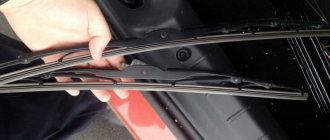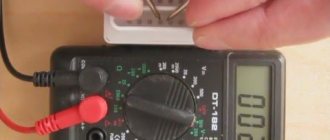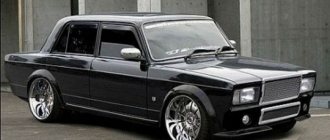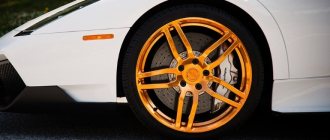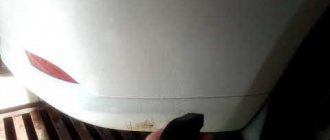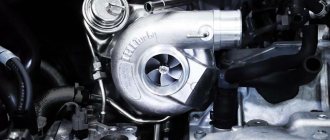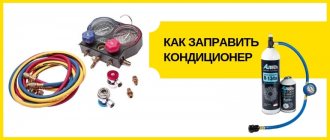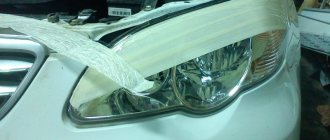How to determine VIN code
To understand how to determine the VIN number for a VAZ car, you need to know where it is located. Even international standards do not require the placement of a VIN code. You can usually find the enamel code for a car in the following ways:
- finding it on the body. The surest way to find out the color code is to look for its presence on the pillars near the driver’s seat, in the windshield area, in the engine compartment, under the trunk;
- "approximately". The least accurate way to determine the shade of the body, which is unlikely to be suitable for partial repainting of the car;
- using specialized sites. There you can search for the composition by code, or, if you don’t know where to look for the color by VIN code, a special field is presented. There you enter the year of manufacture of the car and its model, and the search helps determine the composition code;
VIN code location
To find the VIN code, you must first determine where exactly the nameplate with the identification number is located. Traditionally, automakers attach it in the following places:
- trunk bottom;
- driver's side B pillar;
- space under the driver or passenger seat;
- area at the bottom of the windshield (in its left corner);
- bottom of the front driver's door;
- under the hood.
There are other locations for the nameplate, which vary depending on the manufacturer. Below are the most popular car manufacturers, models and areas where you can view the VIN code:
- Volkswagen - under the spare wheel, in the trunk;
- Hyundai, Ford - on the driver's door, under the hood near the engine;
- Nissan - under the hood on the passenger side next to the windshield;
- Chevrolet - near the radiator, engine, near the windshield;
- Mazda – on the pillars, under the hood, on the front passenger door;
- KIA – in the driver’s door opening;
- Great Wall - on the frame behind the rear right or left wheel.
A clear location of the nameplate has not been established, so the manufacturer can change it at will. Moreover, cars of the same brand assembled at different factories may also have different VIN positions.
Auto enamels codes: location and number
The main purpose of putting a VIN code on the body of each car is to protect the car from theft. However, in addition to this code, the manufacturer can leave an information plate with technical information: car paint code, production date, tire pressure, engine numbers, chassis, etc. Most often, several such plates are located in different places. Each manufacturer has its own marking system and, if desired, can exclude data on the original color; in addition, it may turn out that the data plate is damaged (removed) during operation (repair). Due to the lack of a unified system, it is impossible to determine the exact sequence of actions - this is compensated by many rules and even precise instructions for machines of specific brands.
Where is the VIN number?
The easiest way to find the VIN is to look at the car's registration documents. To do this, open the vehicle passport or its certificate . If for some reason it is not there, then manufacturers can also indicate it on body .
On foreign cars, the VIN code is located under the hood . The symbols are stamped on nameplates (information plates) that cling to the body under the hood near the windshield. In rare cases, it is stamped not on a separate plate, but directly on the body of the car. It happens that the Vin number is duplicated on the counter near the driver's seat .
Vin number under the hood of the car
At American automobile factories (and some others), it is customary to stamp the VIN code on the floor near the threshold of the front passenger seat . To see it, you need to lift the rug.
Vin number under the driver's seat
In the newest cars, the VIN code can also be found in the left corner on the windshield . There should be a nameplate with Vin. In such a place it is considered duplicate and it must also be under the hood or on the floor under the front passenger seat . There are cars where you can find the Vin in the trunk by removing the spare tire. Usually, the VIN code is located there on German cars.
After checking all the indicated places, you will definitely find the Vin of your vehicle.
Additional Information
Information about whether there have been major modifications to the vehicle by welding individual parts from different vehicles can be found using the VIN code.
Based on the code, they select the body type, select the engine and other components, which will be compared during registration. In luxury segment vehicles, special verification characters are used in the VIN code, which help identify a fake.
general information
To make enamel, certain ratios of coloring pigments, base composition, etc. are used. The manufacturer uses several basic color options, but their shades can change from year to year, adjusted by designers, etc. Changes in the enamel used to paint a car can be noted in several ways:
- Name of color (paint).
- Weight ratios of pigments.
- Number in the factory classification.
The location of the plate depends on which marking is adopted by the manufacturer. The standard location of the code is the engine compartment, sometimes a doorway (passenger and driver pillars, the doors themselves). The most popular brands are discussed below - if the car does not fall under this classification, you should look at the entries in the database of the official website. In addition, there are two more possibilities to find out the paint number, and possibly its recipe:
- The VIN number is stamped on each car and cannot be removed during repairs - the code is tied to a very specific car, so the composition and color of the factory paint can be determined using the manufacturer’s databases.
- You can inquire about the color of the car from an authorized dealer.
How to Determine Paint Color Using a Car's VIN
Since the VIN code for selection encodes the paint color number and the amount of pigment in it, before ordering it from the seller, you need to correctly calculate its number.
Manufacturers use digital markings of the paint code in the vehicle's VIN, with the exception of Ford manufacturers, as they designate tones using alphabetic symbols.
The main ways to select a color in a VIN code:
Read also: Great Pyramid of Cholula
- Find a site on the Internet where you can find out the color number by VIN code and you can determine it there.
- Information can be obtained from the seller from whom it was purchased. Car dealership employees can also help you find the VIN number itself, if it hasn’t been found yet.
- The registration document indicates the shade of the paint color, but for more accurate information you will need the code on the vehicle.
- You can contact workshops that specialize in painting, and they themselves will select the desired color immediately before starting work.
What is the difficulty of choosing paint for a car?
Choosing the perfect tone is difficult.
The reason lies in the fact that each paint has unique characteristics. The chances of a perfect match between the color number applied to the vehicle during factory painting and the store paint are reduced to zero. Knowing the type of dye is not enough. Operation changes tone under the influence of sunlight and adverse weather conditions. Even cars of the same batch, but with different mileage, stored in different conditions (garage, street parking), washed with different body care products, have different shades. During painting, the specific application of the previous paint layer can have a significant impact. If the old coating is of poor quality, it is more difficult to achieve an ideal result.
Decoding
VIN code is a set of characters in which all information on the car is encrypted:
- The initial three digits (WMI) indicate the manufacturer: place of production and country of origin.
- The next 5 characters indicate the model, body style, specification, transmission and engine.
- The next character is a control character and does not carry separate information.
- The tenth character determines the year of manufacture of the car.
- The eleventh is the assembly plant where the car was produced.
- The last 6 characters are the serial number of the machine.
How to decipher a car's VIN code
The VIN number is not just a set of letters and numbers. Each part of the VIN code is deciphered and gives the car owner very useful information about the car. For example, by the first characters you can find out the country in which the car was produced. The following symbols provide more accurate information about the manufacturer. The following symbols contain information about the gearbox, body, model, engine, specification. The remaining numbers will help you find out the year of manufacture and serial number.
An example of parsing the VIN number of a car on an OPEL model
Such information can be obtained from the Vin number of any domestic or foreign car. The exception is cars older than 30 years, since such markings were not previously used. There are only other ways to select paint for cars older than 30 years.
The principle and purpose of the VIN number
Vehicle identification number (vehicle identification number), or VIN, is a unique vehicle code consisting of 17 Arabic digits and Latin letters, except O, Q, I (due to the similarity of the latter with numbers). It contains data on the main characteristics of the vehicle, its manufacturer, and year of manufacture. In most cases, the VIN code can be seen on the body, chassis or in other places on specially made plates (nameplates).
Thanks to VIN, you can find out important information about cars and other equipment. This information is entered into the traffic police database, as a result of which, during inspection, the legality of the manufacturer is clarified, the car is not on the wanted list, etc. Even the smallest factories mark vehicles with unique codes and enter the numbers into special registers. For the driver, having a VIN allows you to find out the car’s paint color, if required.
Read also: Who dealt with the RAL color catalog?
Why is this necessary?
VIN (an acronym for Vehicle Identification Number) is a unique code used by the auto industry to identify each car, bus, truck, motorcycle, or even trailer.
The specific and highly complex structure of the VIN code should theoretically ensure that every vehicle manufactured since 1981 has a unique identification number. Thus, it is almost impossible to find two cars with the same VIN. This allows you to assign a code to a specific vehicle and track its history.
What do VIN symbols mean?
The first three characters are called the World Manufacturer Index (WMI). The first tells you what country the car was made in or where the manufacturer's headquarters are located. 2 and 3 signs indicate the manufacturer of the machine.
For example, if the first characters of the VIN code are 1VW, then this is a Volkswagen made in the USA. If the first character was W, it would mean that this Volkswagen was made in Germany. By the way, if a manufacturer produces a small number of cars (for example, in the European Union this means 500 or less cars per year), they always use number 9 as the third character of the VIN.
The middle part (4-9 characters) is the Vehicle Descriptor Section (VDS), which describes the vehicle type. Due to local regulations and other reasons, each manufacturer has developed its own unique system for VDS. Typically, information about the model, body type, engine type, vehicle platform used, number of doors, etc. is provided here.
The last group of characters (10-17) is used as the Vehicle Identifier (VIS) section. This is a unique serial number by which the manufacturer can accurately identify the vehicle. So, VIS reveals everything: from the year of manufacture to the original equipment of the car.
Why is this so useful?
The VIN is used to identify the car. All "life events" of a particular vehicle, such as production, registration, maintenance, accidents, warranty claims, theft, insurance coverage, purchase, etc., are recorded in various registries and databases using the VIN number. Therefore, with the help of software, you can find all this data and generate a report on the history of a particular car.
Just by having a car's VIN number, you can find out not only basic information about the car (year of manufacture, engine power, fuel or transmission type, etc.), but also more specific and useful data. It includes the actual mileage and an archive of photos at different times, if there were any accidents, if it was stolen, how many owners it had, and so on. When you have different data from different dates, you can compare it and detect mileage fraud or hidden accidents.
How to find out the paint color of a car by VIN code
It is not possible to find out the color of a car directly by the VIN code - you only receive detailed information about the model, year of manufacture and factory equipment. But it is this information that allows us to establish a list of paintwork materials that were used specifically for this model during production.
Determination of paintwork online
Knowing the VIN number, you can get information online about the color and shade of the car’s “original” paint. There are several ways to do this:
- Determine the paint code by VIN through the car manufacturer's website. The information will be among the technical information about the car.
- Use specialized search services (Autohistory, Autocode, etc.). Here you also need to enter your VIN code and order a report by email. There is a fee for checking.
- Contact online car paint stores that produce professional computer paint selection based on VIN number. You can also order paint here.
Determining paint color offline
You can find out the car body color yourself:
- Contact your dealer directly.
- Consult a service station (but you will need experienced specialists and modern equipment).
What to consider when choosing auto paint
If we are talking about a used car, it is very important to determine whether it has been completely repainted in order to eliminate the risk of purchasing a “criminal” vehicle. In addition, you need to remember several important rules for choosing paintwork:
- If the former owner changed the color completely, then most likely non-factory paint was used. Therefore, the information obtained by VIN code will be irrelevant, and the color of the existing coating in different places of the body should be compared.
- You can use a paint thickness gauge. Not a single technician at a service station will paint a car as efficiently as they do at the factory. Therefore, the amount of paintwork applied will most likely differ in different places on the body (if the car has been repainted).
- Paint changes its properties over time due to natural conditions. In this case, the shade of the coating in different places of the body will also differ from the original tone according to the VIN code.
- To minimize the risk of choosing the wrong shade, you can turn to spectral paint selection, which allows you to select the right pigments for the paint composition.
- It should be borne in mind that many car manufacturing plants use paintwork that is not commercially available. In such a situation, it will be difficult to find the right color, even if you accurately determine the shade. You will need the services of a professional computer selection of the closest possible shade.
- If the car is more than 10 years old, then the paintwork has most likely already been discontinued. In such a situation, it is also necessary to use complex techniques for selecting and mixing paint colors.
So, using the VIN number it is quite convenient to select the correct paintwork for the car. However, it is good for new and popular car models. With old and repainted vehicles, this method is not always convenient and effective.
To minimize the risk of error, it is better to turn to professionals or request the necessary information directly from the dealer.
pencils aerosols and you need aerosol paint in aerosol packaging for aerosol canspaints aerosol paints aerosol paints aerosol metal aerosol plastic aerosol disks aerosol Duxone car enamels and shades of car enamels especially colors of car enamels that are pearlescent car enamel or car enamelsAerosol car enamel MobicarAerosol car enamel MobihelAerosol car enamel MotipA aerosol car enamels Vika car enamels and
aerosolsauto enamelsmetallicsilverbluegraysilveracrylicmobihelredbeigelight graybright whitegoldenbuy bluebrownpurpleproductsduxoneorderlacquersautomotivequartzcontactscatalogpearlsyourqueenmaterialspaymentcolbeigeorangegoldengoldenaerosoldeliveryprimerraldtpglueseekitputtytoyo tarenault
